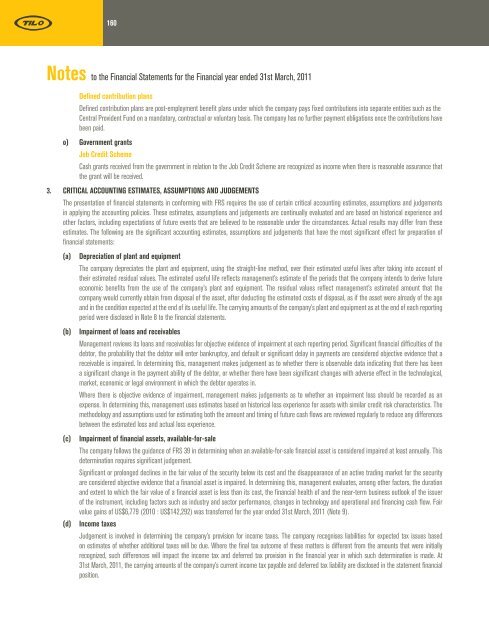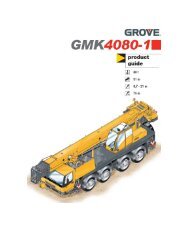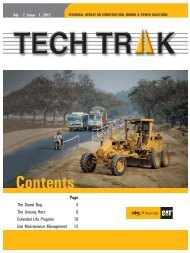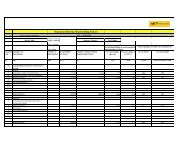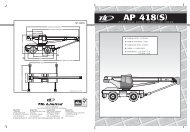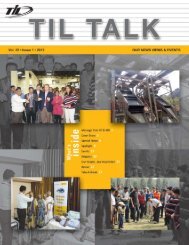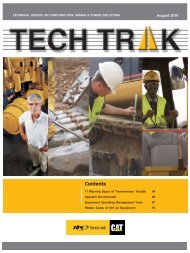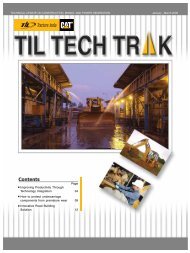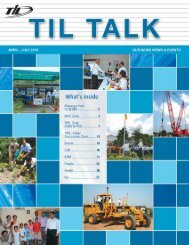view / download the documents. - til india
view / download the documents. - til india
view / download the documents. - til india
Create successful ePaper yourself
Turn your PDF publications into a flip-book with our unique Google optimized e-Paper software.
160Notes to <strong>the</strong> Financial Statements for <strong>the</strong> Financial year ended 31st March, 2011Defined contribution plansDefined contribution plans are post-employment benefit plans under which <strong>the</strong> company pays fixed contributions into separate entities such as <strong>the</strong>Central Provident Fund on a mandatory, contractual or voluntary basis. The company has no fur<strong>the</strong>r payment obligations once <strong>the</strong> contributions havebeen paid.o) Government grantsJob Credit SchemeCash grants received from <strong>the</strong> government in relation to <strong>the</strong> Job Credit Scheme are recognized as income when <strong>the</strong>re is reasonable assurance that<strong>the</strong> grant will be received.3. CRITICAL ACCOUNTING ESTIMATES, ASSUMPTIONS AND JUDGEMENTSThe presentation of financial statements in conforming with FRS requires <strong>the</strong> use of certain critical accounting estimates, assumptions and judgementsin applying <strong>the</strong> accounting policies. These estimates, assumptions and judgements are continually evaluated and are based on historical experience ando<strong>the</strong>r factors, including expectations of future events that are believed to be reasonable under <strong>the</strong> circumstances. Actual results may differ from <strong>the</strong>seestimates. The following are <strong>the</strong> significant accounting estimates, assumptions and judgements that have <strong>the</strong> most significant effect for preparation offinancial statements:(a)(b)(c)(d)Depreciation of plant and equipmentThe company depreciates <strong>the</strong> plant and equipment, using <strong>the</strong> straight-line method, over <strong>the</strong>ir estimated useful lives after taking into account of<strong>the</strong>ir estimated residual values. The estimated useful life reflects management’s estimate of <strong>the</strong> periods that <strong>the</strong> company intends to derive futureeconomic benefits from <strong>the</strong> use of <strong>the</strong> company’s plant and equipment. The residual values reflect management’s estimated amount that <strong>the</strong>company would currently obtain from disposal of <strong>the</strong> asset, after deducting <strong>the</strong> estimated costs of disposal, as if <strong>the</strong> asset were already of <strong>the</strong> ageand in <strong>the</strong> condition expected at <strong>the</strong> end of its useful life. The carrying amounts of <strong>the</strong> company’s plant and equipment as at <strong>the</strong> end of each reportingperiod were disclosed in Note 8 to <strong>the</strong> financial statements.Impairment of loans and receivablesManagement re<strong>view</strong>s its loans and receivables for objective evidence of impairment at each reporting period. Significant financial difficulties of <strong>the</strong>debtor, <strong>the</strong> probability that <strong>the</strong> debtor will enter bankruptcy, and default or significant delay in payments are considered objective evidence that areceivable is impaired. In determining this, management makes judgement as to whe<strong>the</strong>r <strong>the</strong>re is observable data indicating that <strong>the</strong>re has beena significant change in <strong>the</strong> payment ability of <strong>the</strong> debtor, or whe<strong>the</strong>r <strong>the</strong>re have been significant changes with adverse effect in <strong>the</strong> technological,market, economic or legal environment in which <strong>the</strong> debtor operates in.Where <strong>the</strong>re is objective evidence of impairment, management makes judgements as to whe<strong>the</strong>r an impairment loss should be recorded as anexpense. In determining this, management uses estimates based on historical loss experience for assets with similar credit risk characteristics. Themethodology and assumptions used for estimating both <strong>the</strong> amount and timing of future cash flows are re<strong>view</strong>ed regularly to reduce any differencesbetween <strong>the</strong> estimated loss and actual loss experience.Impairment of financial assets, available-for-saleThe company follows <strong>the</strong> guidance of FRS 39 in determining when an available-for-sale financial asset is considered impaired at least annually. Thisdetermination requires significant judgement.Significant or prolonged declines in <strong>the</strong> fair value of <strong>the</strong> security below its cost and <strong>the</strong> disappearance of an active trading market for <strong>the</strong> securityare considered objective evidence that a financial asset is impaired. In determining this, management evaluates, among o<strong>the</strong>r factors, <strong>the</strong> durationand extent to which <strong>the</strong> fair value of a financial asset is less than its cost, <strong>the</strong> financial health of and <strong>the</strong> near-term business outlook of <strong>the</strong> issuerof <strong>the</strong> instrument, including factors such as industry and sector performance, changes in technology and operational and financing cash flow. Fairvalue gains of US$6,779 (2010 : US$142,292) was transferred for <strong>the</strong> year ended 31st March, 2011 (Note 9).Income taxesJudgement is involved in determining <strong>the</strong> company’s provision for income taxes. The company recognises liabilities for expected tax issues basedon estimates of whe<strong>the</strong>r additional taxes will be due. Where <strong>the</strong> final tax outcome of <strong>the</strong>se matters is different from <strong>the</strong> amounts that were initiallyrecognized, such differences will impact <strong>the</strong> income tax and deferred tax provision in <strong>the</strong> financial year in which such determination is made. At31st March, 2011, <strong>the</strong> carrying amounts of <strong>the</strong> company’s current income tax payable and deferred tax liability are disclosed in <strong>the</strong> statement financialposition.


